1lumen selects and reviews products personally. We may earn affiliate commissions through our links, which help support our testing.
Thrunite Catapult Pro review: flashlight test

Thrunite Catapult Pro specifications
| Brand & Model | Thrunite Catapult Pro |
|---|---|
| LED | Luminus SFT-70 |
| Lumens | 2,713 Lumens |
| Beam intensity | 252,500 cd |
| Battery config. | 1*26650 |
| Onboard charging | USB-C |
| Modes | 4 |
| Blinkies | Strobe |
| Reflector | Smooth |
| Waterproof | IPX8 |
| Review publication date | September 2022 |
Introduction:
Thrunite is a common name these days. Although not producing breakthrough products the likes of Olight, Lumintop, Astrolux, or Nightwatch, they have been in business a long time and have firmly established a strong footing in the market. With warehouses all over the world including the USA and EU, they have a solid network of retailers. One way they’ve done this is by making a nice light at an affordable price, and every Thrunite light I’ve tested has been solidly built with respectable performance while being very user-friendly. Of all the Thrunite products I’ve reviewed, they’ve all fit that mold: High quality, simple to use, and sporting good performance.
From small EDC lights to huge, high output multi-LED lights, Thrunite makes something for everyone at very respectable price points. Although a lot of nice lights have rolled out of the Thrunite camp, one of the popular ones is their Catapult compact thrower flashlight. Originally launched in 2018, the Catapult featured a single 26650 form factor with a 57 mm reflector. Paired with a Cree XHP35 HI LED, it produced around 750 m of throw at 1700 Lumens. Not too shabby. The Catapult was upgraded along the way in 2021 to a (way different) LED, but was otherwise unchanged.
Fast-forward another year, and Thrunite has released another Catapult: the Pro. The differences are not subtle, with a head that’s grown 10 mm wider, lost some heat sinking fins, and gained a brand new emitter. Aside from a Lumen deficit, otherwise the most important spec has improved quite a bit (on paper). Let’s take a closer look.
Package quality.
Thrunite’s packaging is a bit blase mixed with art deco, so you get an otherwise functional, sturdy box with a lift-off lid and smartly arranged contents, which I really like. It’s better than a throw-away box like you get with other brands. Inside, the Catapult Pro is snuggled inside the holster with the accessories in a small baggie nearby. Here’s what’s inside.
- Thrunite Catapult Pro
- Thrunite 5000 mAh 26650 (loaded in the light)
- Holster
- Spare o-rings
- Lanyard
- Manual
- Spare USB charge port covers
- Spare switch boot
- USB type C charging cable
- Split ring
Once again, Thrunite impresses with a superbly comprehensive assortment of bits, and everything you need (besides a wall charger) to get going. The battery was charged to 3.84 volts for decent output out of the box as well. Overall, no complaints and the accessories seem good quality as usual.
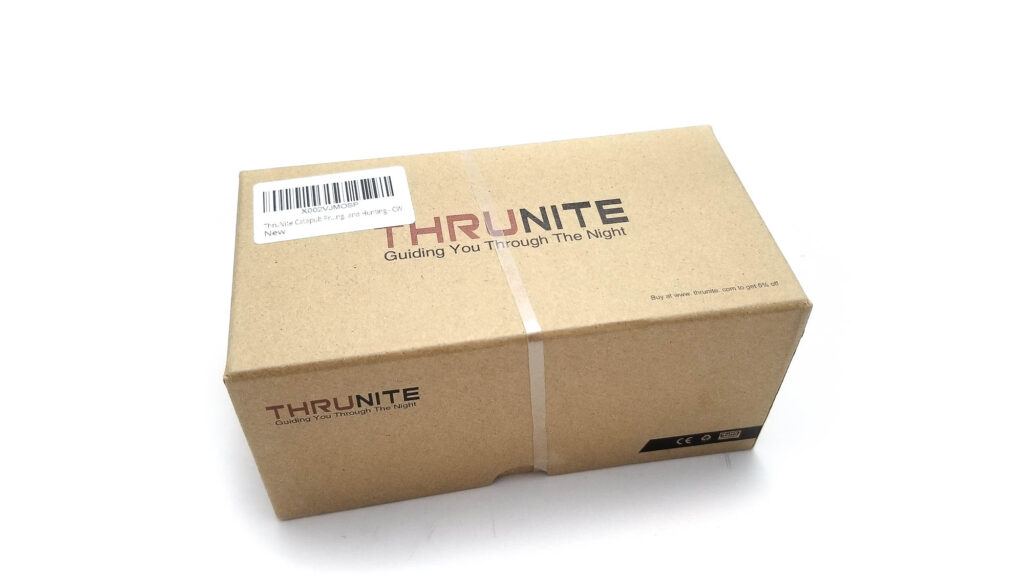
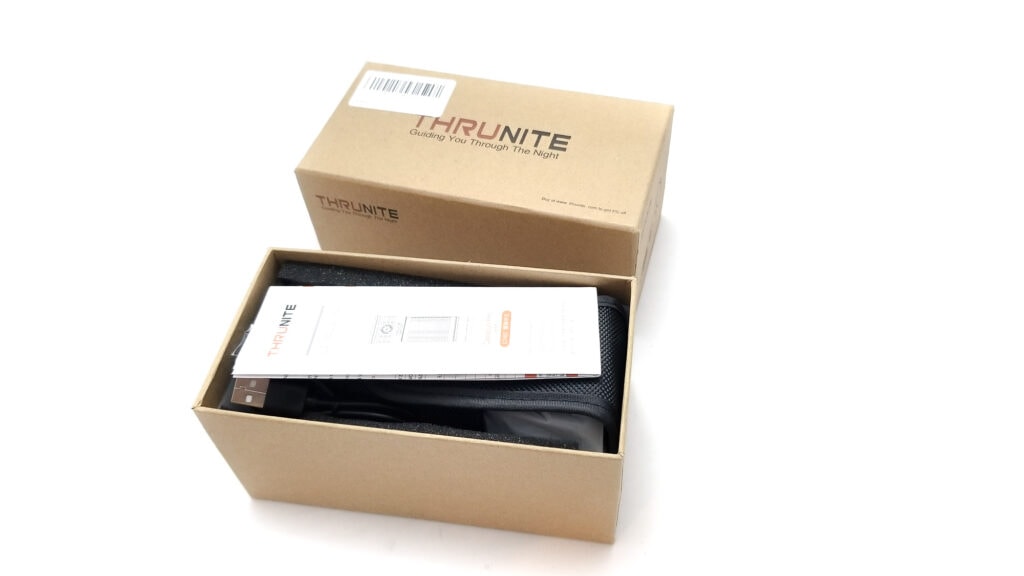
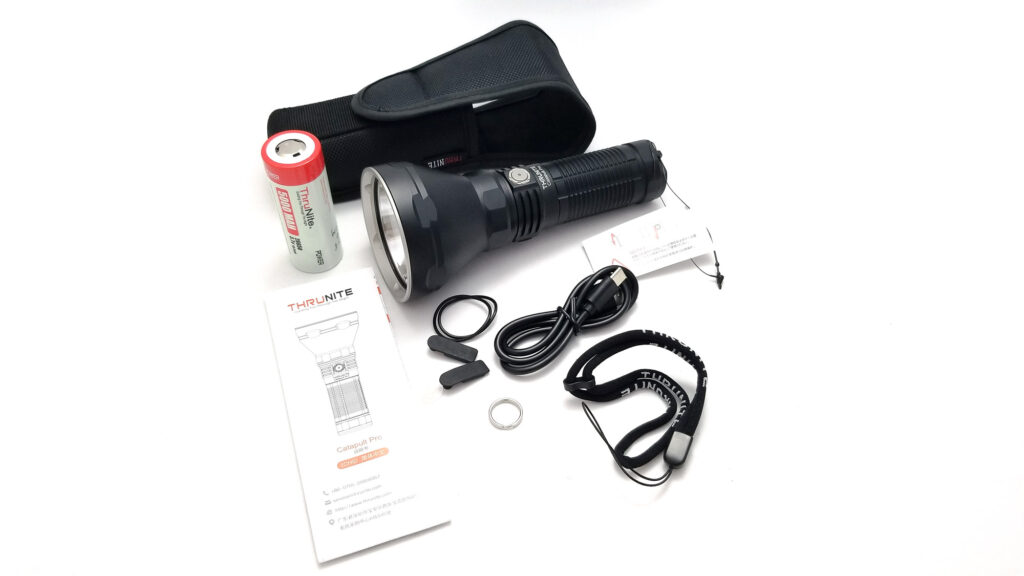
Flashlight in use
The Catapult V6 series and the Pro are compact thrower flashlights. With a head a bit bigger than a C8 and a fat-stubby 26650-size body, they’re too big for EDC, but will happily ride in a jacket or cargo pocket. The Catapult V6 and Pro are good for general purpose use cases, from everyday flashlight duties to cases where you need a bit more reach than your SST40 or Osram W2 C8 could manage. I found it to be a nice middle-ground between the Fenix TK20R V2 and Acebeam L18.
Thrunites are usually very user-friendly lights. The Pro version is a bit bigger than the standard Catapult V6, but nonetheless pocketable and the extra size doesn’t hurt the handling dynamics. That chubby 26650 tube fills out big hands fine, and offers good purchase real estate for smaller mitts as well. The grippy texturing on the battery tube hasn’t been carried over from the V6 and is borrowed from the TC20 V2. It’s really effective and grippy, and the balance is also pretty neutral, about like a front-heavy TC20 V2 (the Pro shares the TC20’s switch, battery tube, and tailcap).
The USB type C charge port is opposite the switch, and it’s sealed with a nice, unobtrusive rubber seal. It is a bit tough to reseat after opening though, so make sure to fully seat it or it creates an ingress point for water and crud.
There’s a single e-switch behind the head, and it’s nearly identical to the TC20 V2, with a barely protruding button and a very short action. The button and bezel are a matte finish metallic material, and the button has a single LED indicator in the middle for battery state and charging status, but it’s only active when the light is turned on or charging. I’m not a huge fan of these smaller Thruite switches, as they feel kind of vague and almost unpredictable with double-clicks or triple-clicks. It’s the same story here. The switch works and the action feels good with decent feedback, but that vagueness is still there.
There’s a single lanyard attachment point at the tailcap, and the hole is one again woefully small for the lanyard, and unless you’ve got fingers like Tinkerbell, it will be an eternal struggle to get it threaded. Thankfully, like some other Thrunites, they included a split ring that can be installed in the lanyard hole, and I found that a much better option. Tail standing is super stable, but don’t count on the Pro staying put on a less-than-level surface since there’s no anti-roll provisions.
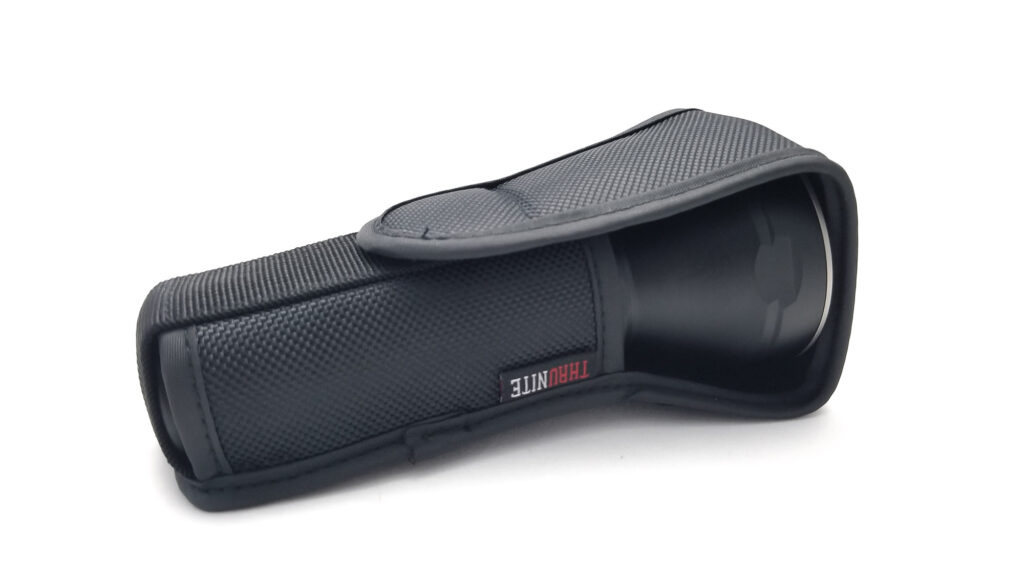
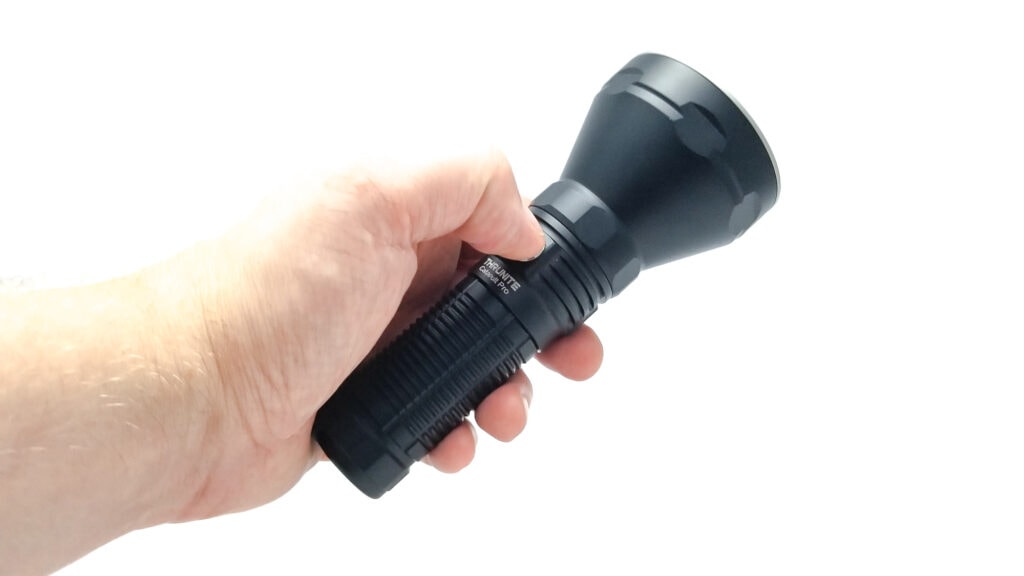
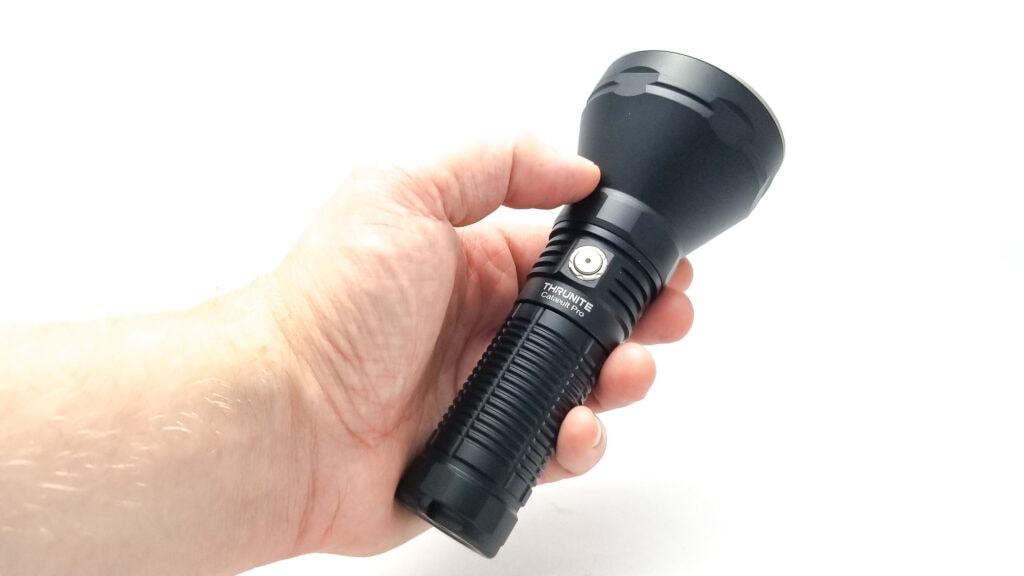
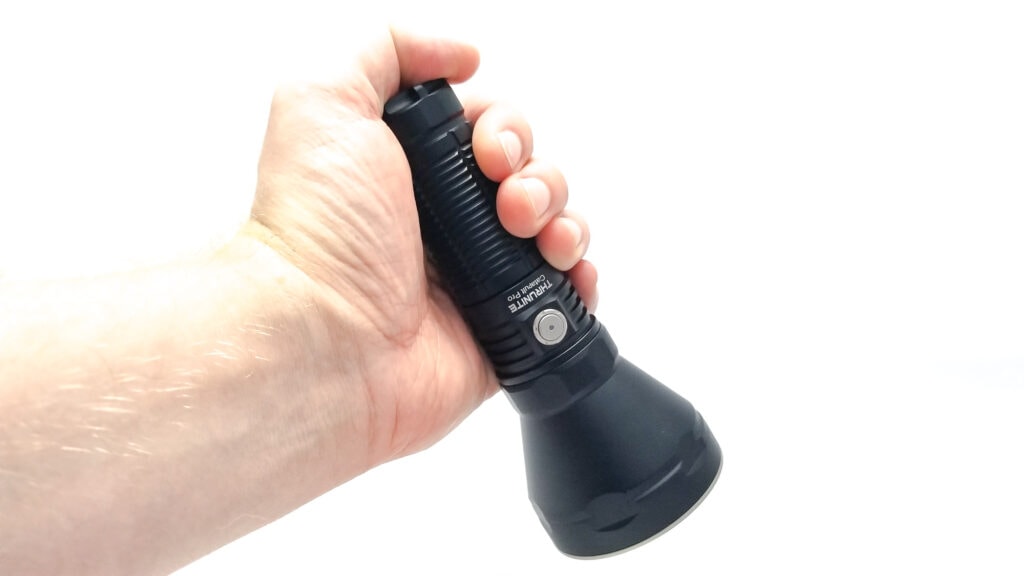
Build Quality, and Warranty
Every Thrunite I’ve handled and tested has been solid and well-made with good fit and finish, sometimes above the asking price. The Catapult Pro retails for $99 MSRP, which seems a bit steep, but expect street prices to be in the mid $80 range, a really good deal for a solid light. All the parts fit together very well with no anomalous gaps or misaligned joints. The light is milled from aircraft aluminum, so who knows what that is, and the machining is good and tidy with no visible or obvious defects.
The anodizing is the typical Thrunite semi-matte black anodizing, advertised as type III HA, and this time it’s a bit less glossy than my TC20 V2. It looks really good with no defects or bald spots, save for a slight blemish on the threaded part of the battery tube (out of sight out of mind though). The bezel is matte-finished and looks nice as well, and the lens didn’t have any grubby fingerprints on it. Overall, quality control is good. The threads are nice and sturdy rectangular cut units. Unlike other flashlights and versions of the V6, the Catapult Pro doesn’t have a removable tailcap.
The battery tube is one piece and can only be loaded from the front. The front threads are fully anodized, and feature a long ‘snout’ part that interfaces with the head and driver ground ring. There’s no spring on the driver end, just a brass contact, but the tailcap features a dual gold-plated spring arrangement for good current handling. There’s a bunch of o-rings sealing every joint, and the USB charging port cover creates a nice seal. With a glued-up head, Thrunite gives the Pro an IPX8 rating for 2 meters of (temporary) immersion.
For warranty, Thrunite gives you a good one, and it varies by the outlet you purchased it through (Amazon has a different return policy than Thrunite’s online store, but generally it’s a 30-day no hassle return policy followed by a 2 year limited lifetime warranty with coverage for factory defects or failures for 24 months, and lifetime coverage with the buyer paying shipping and any parts required for repair.

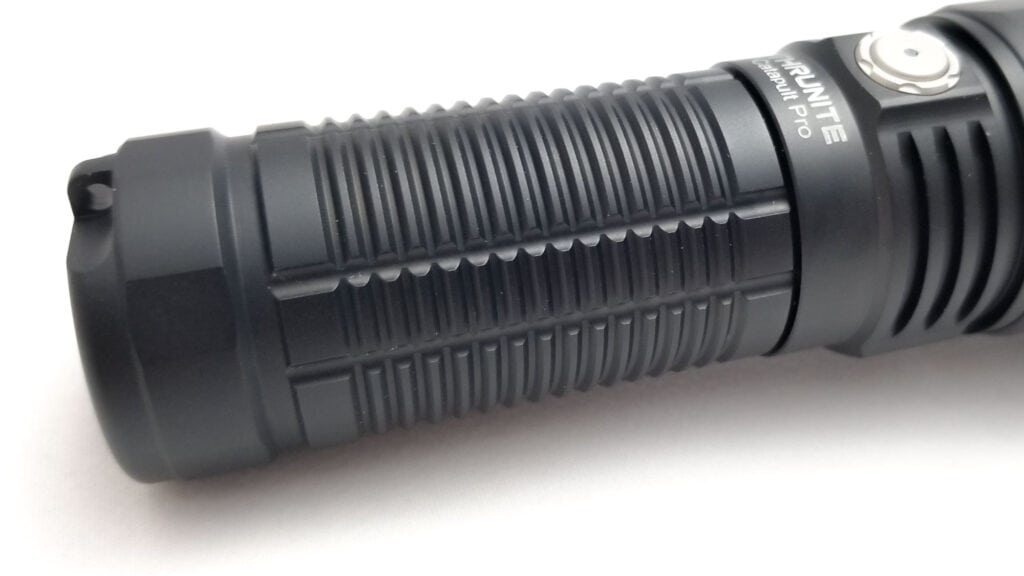
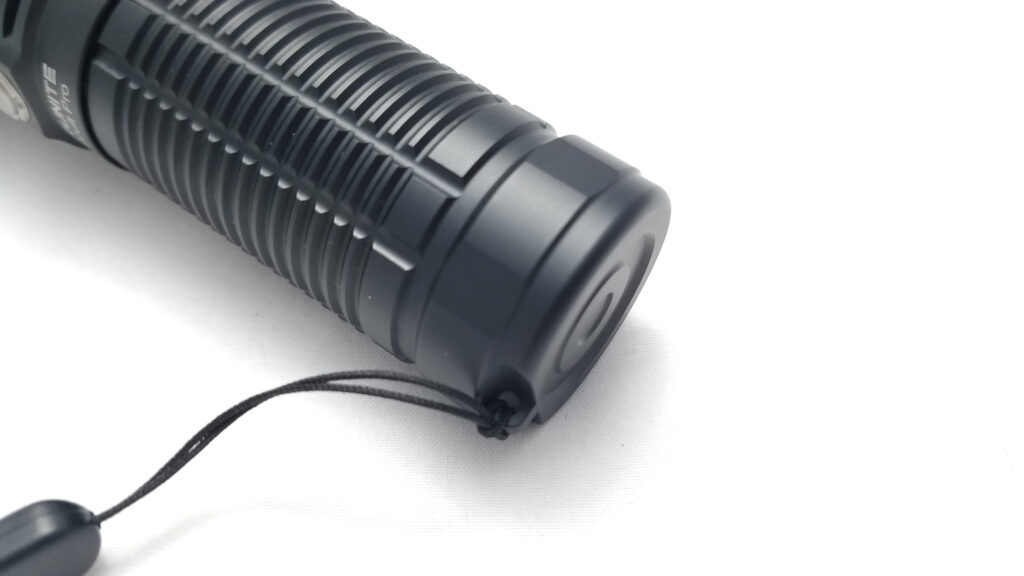
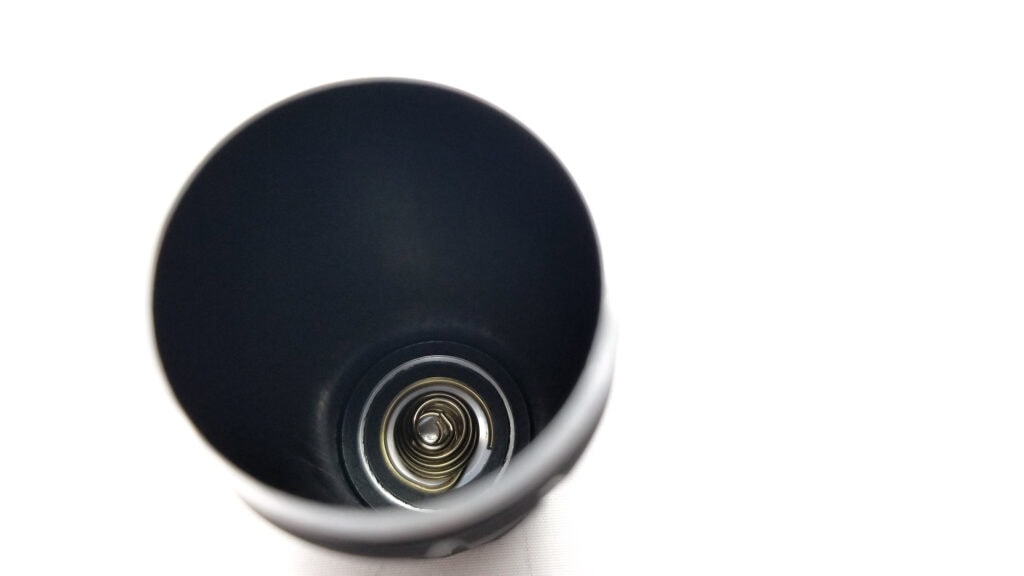
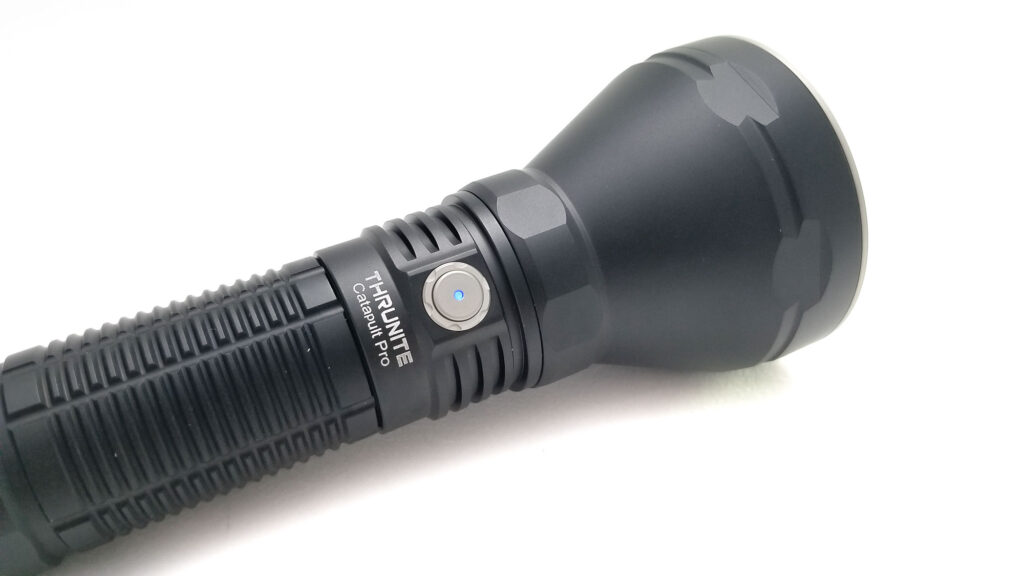
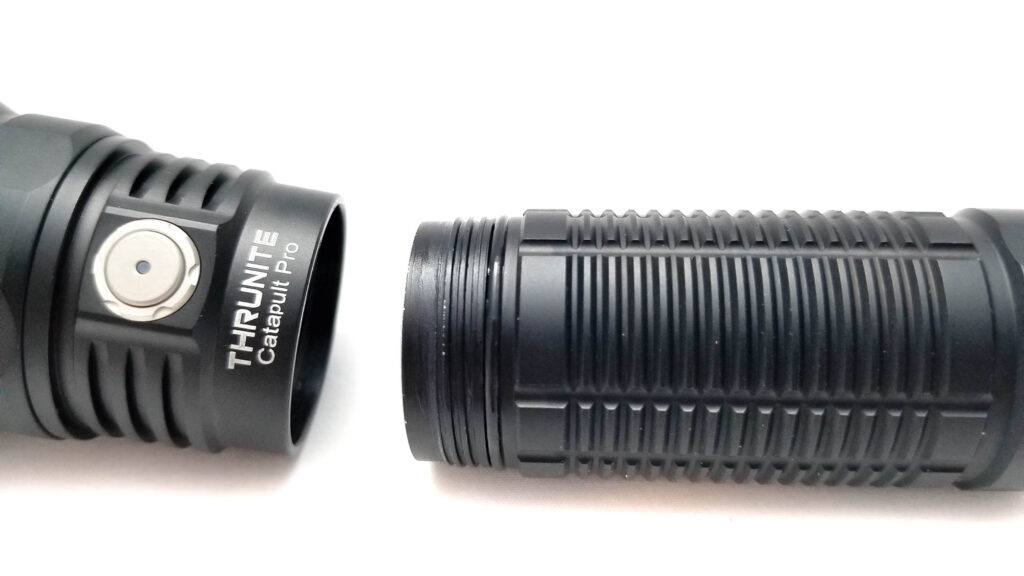
LED, Lens, Bezel, Beam, and Reflector
The original Catapult V6 featured the Cree XHP35 HI, but it’s since been discontinued, so the next V6 chucked it in favor of a Luminus product, the SST70. While I like the SST70, the updated V6 got a bit of hate mail from 1st gen V6 owners since it was less of a thrower and more general purpose. It wasn’t much better than the XHP35 HI version throw-wise, but did make about 2000 more lumens. For the Pro, Thrunite heeded the hatemail, and recruited another Luminus product, the SFT-70. Before I go any further, this is not a dedomed SST70. The SFT-70 is a fairly new LED to the flashlight world, and it’s pretty special. I reviewed it in the Fenix TK20R V2 and Olight Warrior 3S, and it was a really nice upgrade from the SST70. It still has bond wires, but they’re potted in the substrate on the die which makes the new design more robust. Even without the dome, it maintains 90% of the SST70s output with a nice increase in throw.
The LES is about 6.4 mm2, so it’s a bit bigger than the XHP35 HI at 5.3mm2. No CCT value is advertised, other than “cool white” and that makes sense because the SST and SFT series LEDs are basically relegated to CW purgatory. No biggie though since it’s a thrower.
At about 3 meters from the sensor on Infinity High, the Opple Lightmaster Pro has the tint coming in at 5462K and CRI 60.3 Ra. Duv is 0.0101, so a bit on the green side. The reflector is an SMO unit, and it’s topped with a AR coated mineral glass lens. The bezel looks to be either bead blasted aluminum or stainless steel. It’s not crenulated, and definitely glued. The lens is set back about 4.5 mm from the edge of the bezel, so it would be well protected from drops. The beam is very versatile and not an all-out thrower beam like I expected. There’s abundant spill with a tight, superbly focused hotspot. Honestly, it’s a very, very nice thrower beam. I did notice a donut hole, but after about 3 meters, it’s gone.
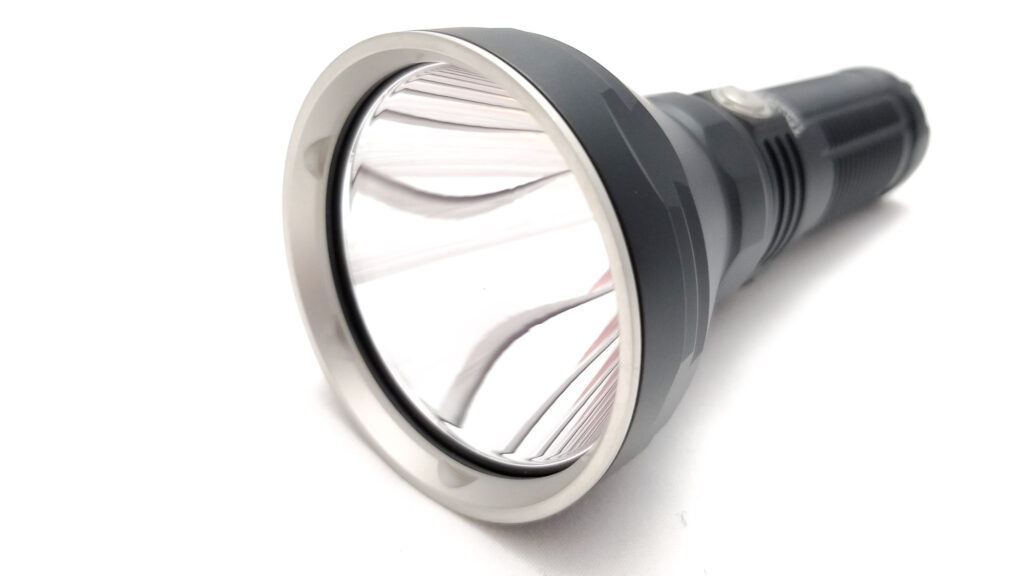
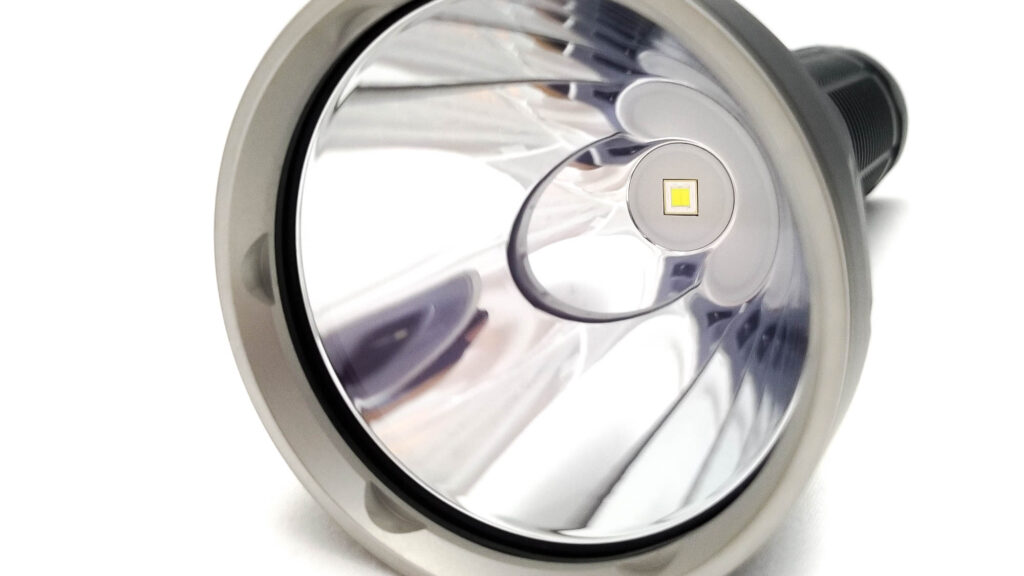
Dimensions and size comparison
Dimensions:
| Dimension | Millimeters | Inches |
|---|---|---|
| Length | 150.5 | 5.92 |
| Head diameter | 65 | 2.55 |
| Body diameter | 33.5 | 1.31 |
Weight:
| Weight | Grams | Oz. |
|---|---|---|
| Without battery | 308 | 10.9 |
| With battery | 207 | 7.4 |
Flashlight size comparison with its competition
I compared the Catapult Pro to some other similar sized throwers and general purpose flashlights.
Group 1 Thrunite Flashlights: Thrunite BSS V4, Thrunite T2, Thrunite Catapult Pro, Thrunite TC20 V2
Group 2 left to right: Fenix TK20R V2, Thrunite Catapult Pro, Thorfire C8, Olight Warrior 3S Limited Edition titanium
Group 3 left to right: Acebeam L19 V2, Speras T3R, Thrunite Catapult Pro, Convoy L21B
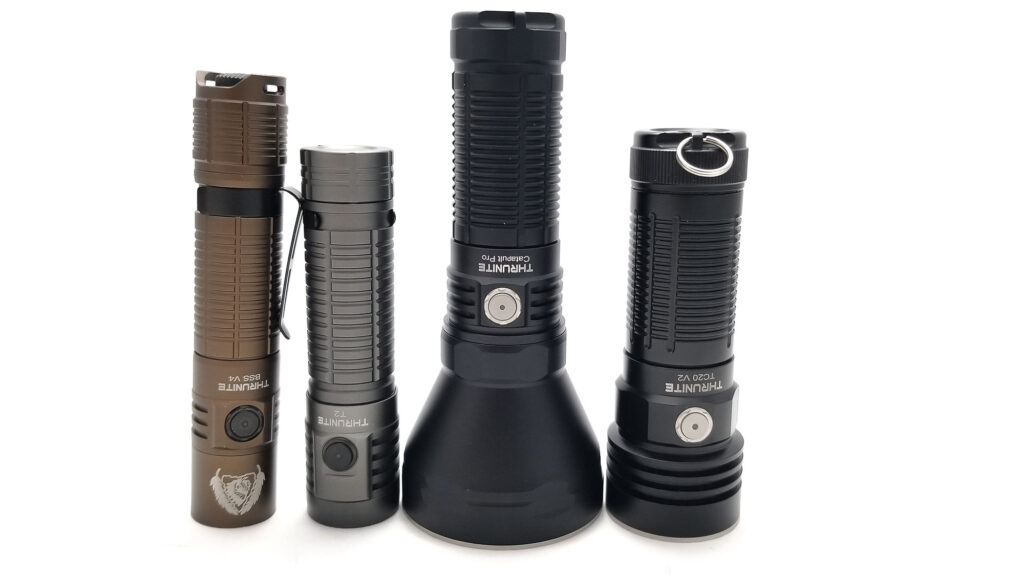
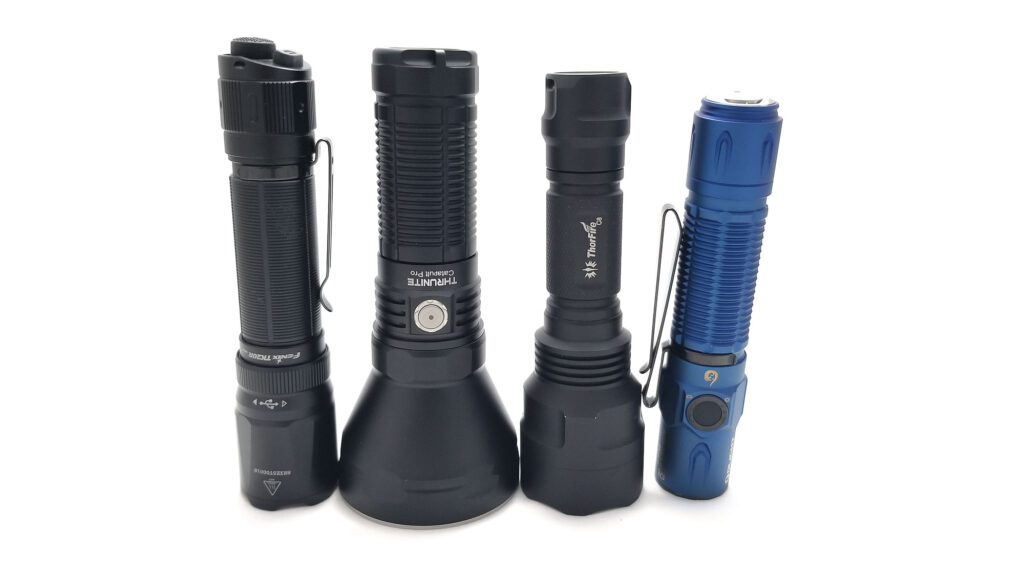
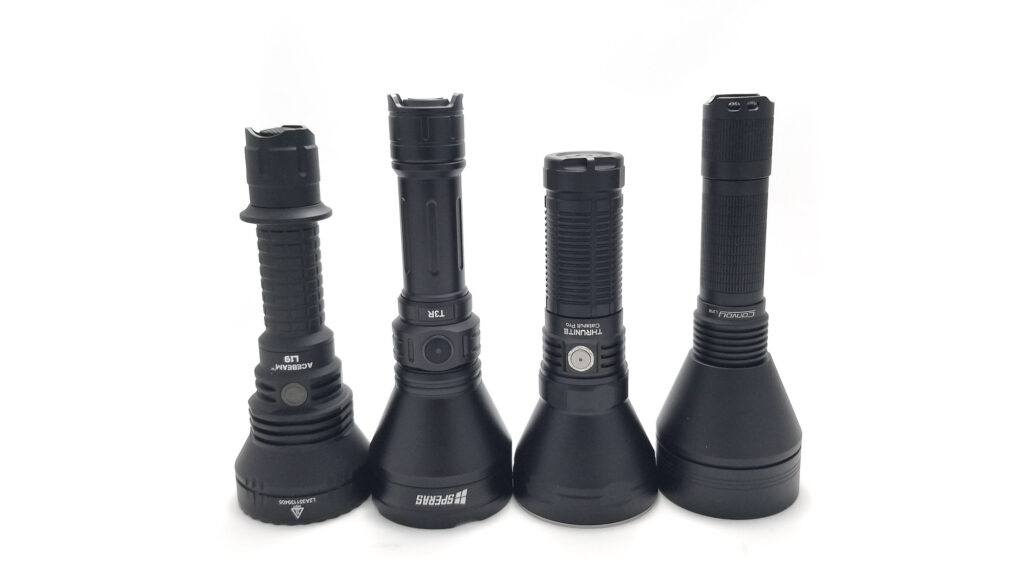
Driver & User Interface:
The Catapult lights have always featured boost drivers. These are single cell lights and since they use 6 volt emitters, they must boost the 4.2 volt from the battery to a voltage the LED can use. I really like boost drivers and buck drivers since they provide laminar output so long as there’s enough energy in the battery to stay in regulation.
The UI is one I haven’t seen before on a Thrunite product. Instead of the usual stepped ramping UI of the V6 lights, the Pro has a smooth ramping UI. Generally I haven’t been impressed with ramping UIs that don’t start with A and end with nduril, so maybe I’ll be surprised. Thrunite breaks their modes into basically 4 set modes, with infinitely variable brightness in between. The top of ramp is called Infinity High, and the ramp bottom is Infinity Low. There’s the obligatory Strobe/SOS, Firefly mode, and Turbo available with some clicks.
Available modes: Infinity High, Infinity Low, Turbo, Firefly
Available blinky modes: Strobe
User interface:
From OFF:
- Press and Hold: Pressing and holding for 2 seconds will activate Firefly mode.
- Single click: Turns on in last mode
- Double click: Turbo
- 3 clicks: Strobe
From ON:
- Press and Hold: Ramps up. Release and hold to ramp down.
- Single click: Turns off
- Double click: Turbo
- 3 clicks: Strobe
Mode memory:
- Yes, last mode memory. Turbo and Strobe are not memorized.
Shortcuts:
- To Firefly: Press and hold from off 2 seconds
- To Turbo: Double click in any state
- To Strobe: Triple click in any state
- Lockout: From off, press and hold the switch for about 5 seconds to activate the lockout
Low voltage warning:
- The switch LED will show battery status during operation: Solid blue 100% to 21% (4.2 to 3.2 volts), solid red 20% to 10% (3.2 to 3.0 volts), blinking red 10% to 1% (3.0 to 2.8 volts). The light will switch off if the voltage drops below 2.8 volts under load.
Strobe/blinkies
- Single strobe can be activated with a triple click in any state.
Lock-out mode:
- Yes, electronic lockout is accessed from Firefly mode. In Firefly mode, press and hold the switch for about 2 seconds until the light shuts off. The light will not turn on if the button is clicked again and the switch LED turns red. To unlock, repeat the process and the light turns on Firefly mode. You can manually lock the light out also by unscrewing the battery tube about ⅛ turn.
PWM
- None
Additional info on the UI:
- Okay, so we already know that Anduril is the benchmark for smooth ramping UIs, and any other manufacturer trying to emulate Anduril’s level of precision and ramping speed undoubtedly have some big shoes to fill. That said, I’d rate the Catapult Pro’s smooth ramping as adequate. It’s a bit like the smooth ramping UI of the Amutorch DM90 and XT series lights I reviewed.
- In all honesty, the Catapult Pro UI isn’t perfect, but it’s not terrible either. The ramp speed is not exponential and pretty slow going. From on to Infinity High mode takes 5.5 seconds, with a slow triple blink indicating the top (Infinity High) and lowest mode (Infinity Low). The major annoyance I ran into was sometimes when ramping up from turn-on in Infinity Low, the light would do the 3 blinks, ramp down slightly, then ramp back up. If you kept holding the button down, it would perpetually ramp from Infinity High to Infinity Low, sort of like Crescendo UI. The Turbo switching is also touchy and a bit vague, requiring carefully timed button presses to get it to activate. Also, when in Turbo, double-clicking does nothing. Deactivating Turbo requires turning the light off, then turning on again. Thrunite doesn’t specify any thermal regulation, but Turbo is on a timed step down.
Batteries & Charging
The Catapult pro, like the V6, uses a single 26650 size lithium-ion battery for power. Although 21700 batteries (I think) are a better option in late 2022 due to their higher energy density and discharge rates, Thrunite is content to use 26650s, and that makes sense here since the light doesn’t need a 25 amp battery. The light comes with a Thrunite-branded 5000 mAh flat top protected 26650 good for 18.5 Wh. No discharge figure is listed, but it should easily provide the 9-10 amp input voltage and return long runtimes. The light also retains the V6’s USB type C onboard charging. It’s rated at 2 amps (about 10 watts), so figure on the battery charging in about 3 hours. I charged it in my Vapcell S4+ and got around 22 milliohms for internal resistance. The protection circuit cut the charge voltage at 4.18 volts. A discharged battery recharged at 1.9 amps after about 25 minutes on the charger according to my Ruideng AT35 USB tester. Unlike the TC20 V2, the Catapult Pro worked on USB type C to C charging, albeit at 1.7 A.

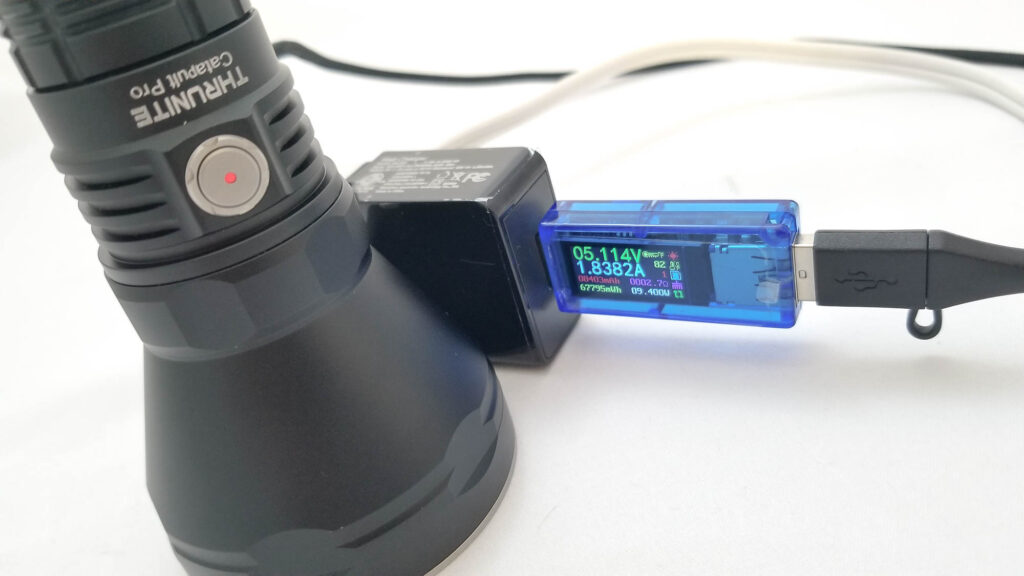
Performance test
Lumen measurements
Lumens were measured using my home made 50 cm integrating sphere with a Digi-Sense 20250-00 datalogging lux meter. It’s been calibrated with many lights, and is within 10% of actual output. I used the included, fully charged 5000 mAh 26650 battery. I couldn’t measure the current for each mode due to the inaccessible current path.
| Mode | Specs | turn on | 30 sec | 10 minutes |
|---|---|---|---|---|
| Firefly | 0.7 | 1.3 lm | 1.3 lm | – |
| Infinity Low | 42 | 59 lm | 59 lm | – |
| Infinity High | 1482 | 1490 lm | 1463 lm | 1370 lm |
| Turbo | 2713 | 2921 lm | 2616 lm | 991 lm |
I also took a measurement at what looked like 50% (halfway) in the ramp and got 890 Lumens at turn on, maintaining better than 800 Lumens for over 2.5 hours. Infinity High held over 1300 Lumens for nearly 20 minutes and better than 1000 for another 1 hour 26 minutes. Turbo was down a bit, but still holding nearly 900 Lumens or better for most of the runtime. Very impressive! This is why I love boost drivers in flashlights.
Parasitic drain:
- N/A can’t measure
ThruNite Catapult PRO battery Life: runtime graphs
Runtimes were measured using the 50 cm integrating sphere with the Digi-Sense 20250-00 datalogging lux meter using the fully-charged included 5000 mAh 26650 battery. I tested Infinity High and Turbo since Infinity Low runs for almost 3 days. I also tested the runtime at roughly 50% ramp.

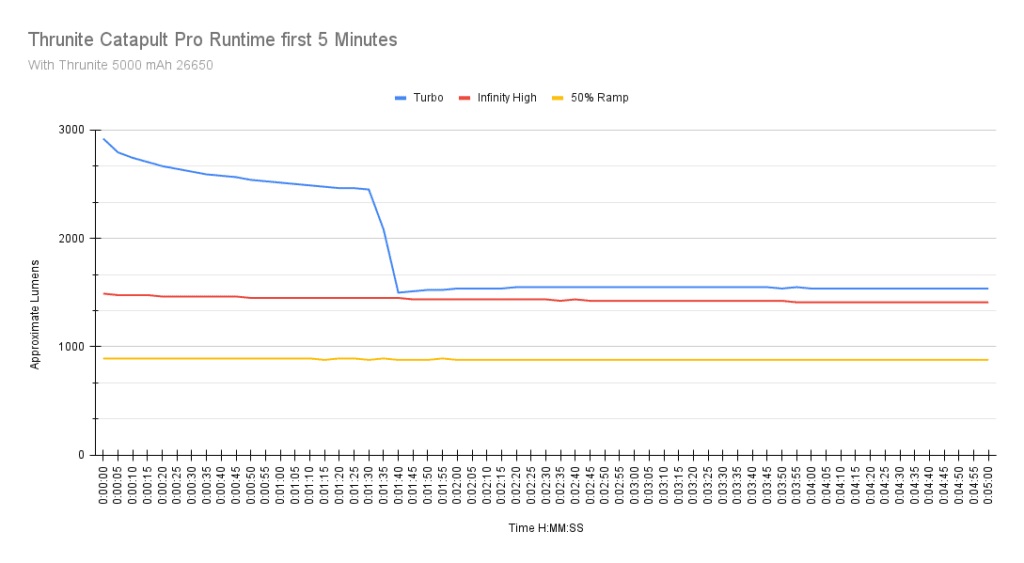
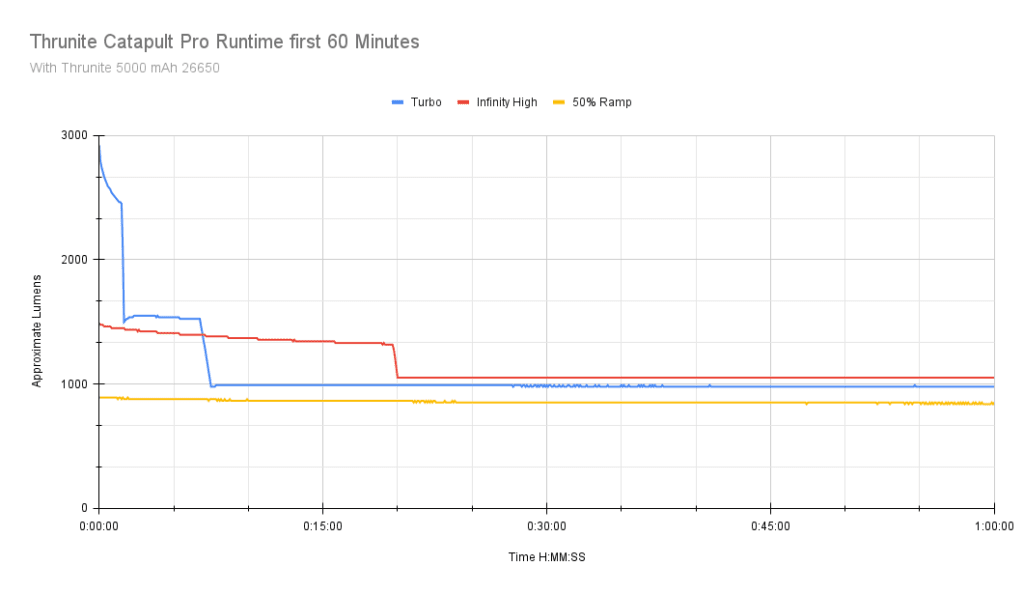
| Mode | Specified | Measured runtime (ANSI) | Time till shut off |
|---|---|---|---|
| Firefly | 42 days | – | – |
| Infinity Low | 53h | – | – |
| 50% Ramp | N/A | 2h 38min | 2h 38min |
| Infinity High | 2h 24min | 2h | 2h |
| Turbo* | 1h 39min | 1h 57min | 1h 58min |
I included the run for the 50% ramp to show the difference between the fixed brightness modes and mid ramp. I about met Thrunite’s runtime specs as well. No complaints here. The thermals were also well regulated. Turbo has a step down, but Infinity High doesn’t need thermal intervention. The light never got over 57 C, and was comfortable to hold the entire runtime. The battery was consistently discharged to 3.1 volts. The light was not usable after the tests.
ANSI FL1 standards: The runtime is measured until the light drops to 10% of its initial output (30 seconds after turning on). This does not mean that the flashlight is not usable anymore. The last column shows how long the light actually works till it shuts off. If there is a + symbol, it means that the test was stopped at that particular point, but the light was actually still running. This happens on certain occasions, with certain drivers, firmware, or batteries.
Peak beam intensity and beam distance measurements
Beam distance and intensity figures were measured with the Uni-T UT383S indoors at 5 meters. I used the fully charged 5000 mAh 26650 battery. All measurements recorded at 30 seconds. I usually measure 1000 meter lights indoors at 5 meters.
| Mode | Specs | Candela measured | Meters | Yards |
|---|---|---|---|---|
| Firefly | ? | 25 | 10 | 10.9 |
| Infinity Low | ? | 5425 | 147 | 161 |
| Infinity High | ? | 128,600 | 717 | 784 |
| Turbo | 252,500 cd | 287,750 cd | 1073 | 1173 |
No throw specs were advertised save for the 252,500 cd figure (probably Turbo). These are very impressive throw figures, and shows the excellent performance of the SFT70 in a properly tuned reflector. Even Infinity High mode is over 700 meters, which is enough throw for most every task you’d use this light for. This is SFT-40-W throw figures with 40% more output.
Extra info: Peak beam distance according to ANSI FL1 standards: The calculated value of distance in meters at which the flashlight produces a light intensity of 0.25 lux. (0.25 lux is about the brightness of a full moon shining on an object).
Beamshots
I compared the Thrunite Catapult Pro to some other 1,000 m+ capable flashlights. The tower is about 950 meters distant. Photos taken with my Samsung Note 8 set to 0.5s, ISO400 and 5000K WB.
Beamshots compared to the following flashlights:
- ThruNite Catapult Pro
- Acebeam L19
- Acebeam L19 V2
- Speras T3R
- Convoy L21B
- Lumintop PK21
- Nitecore MH40S

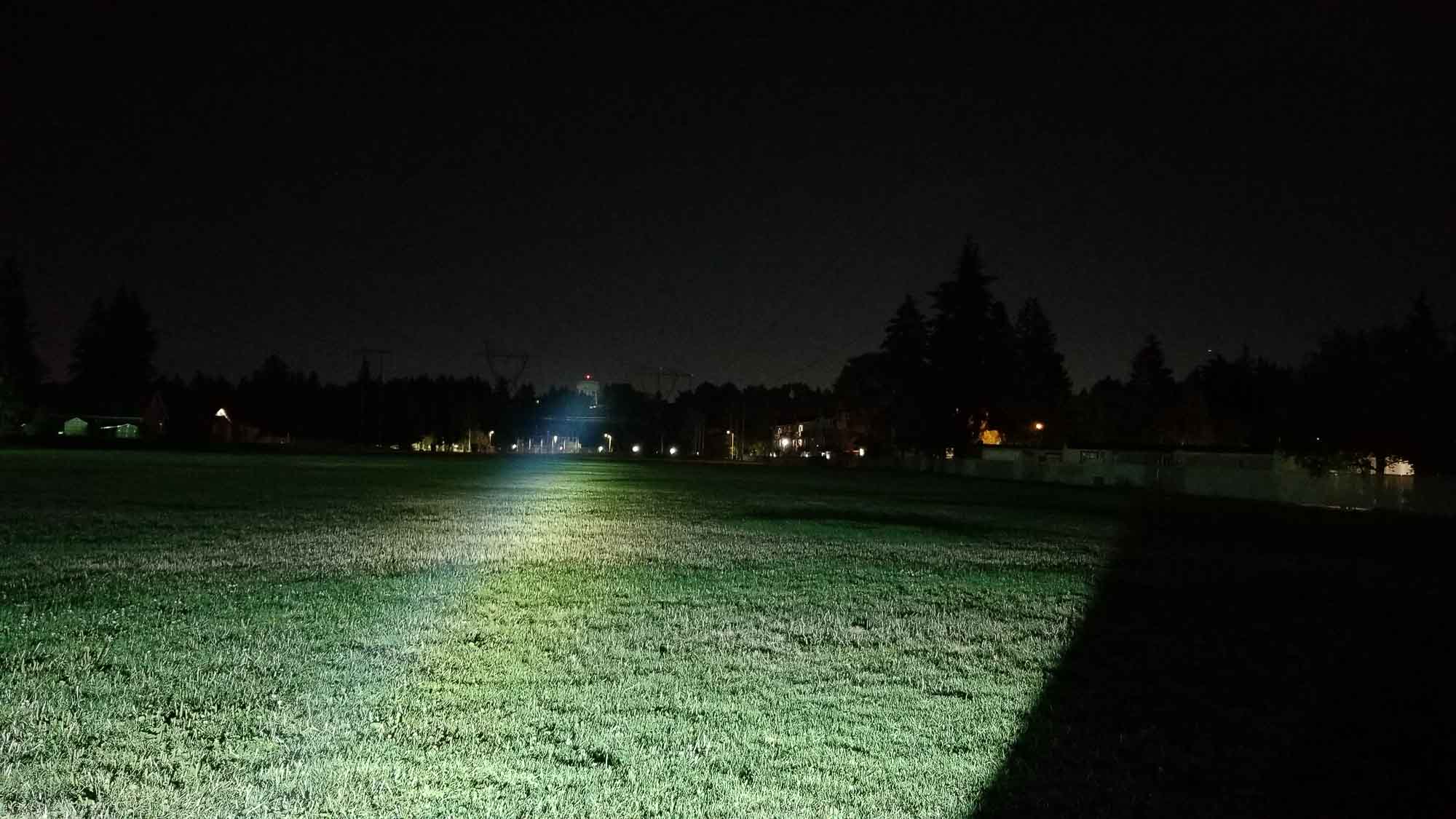
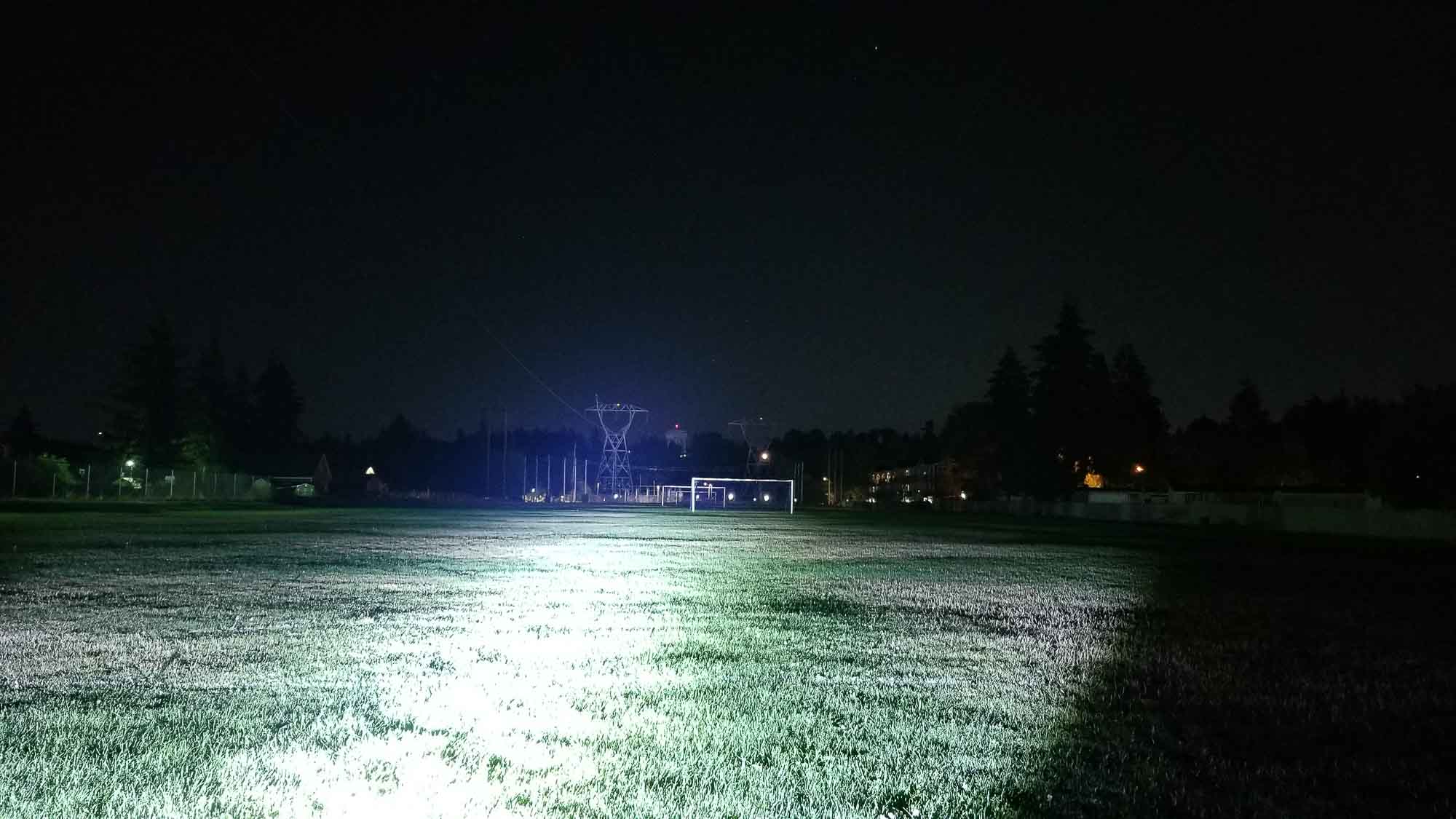
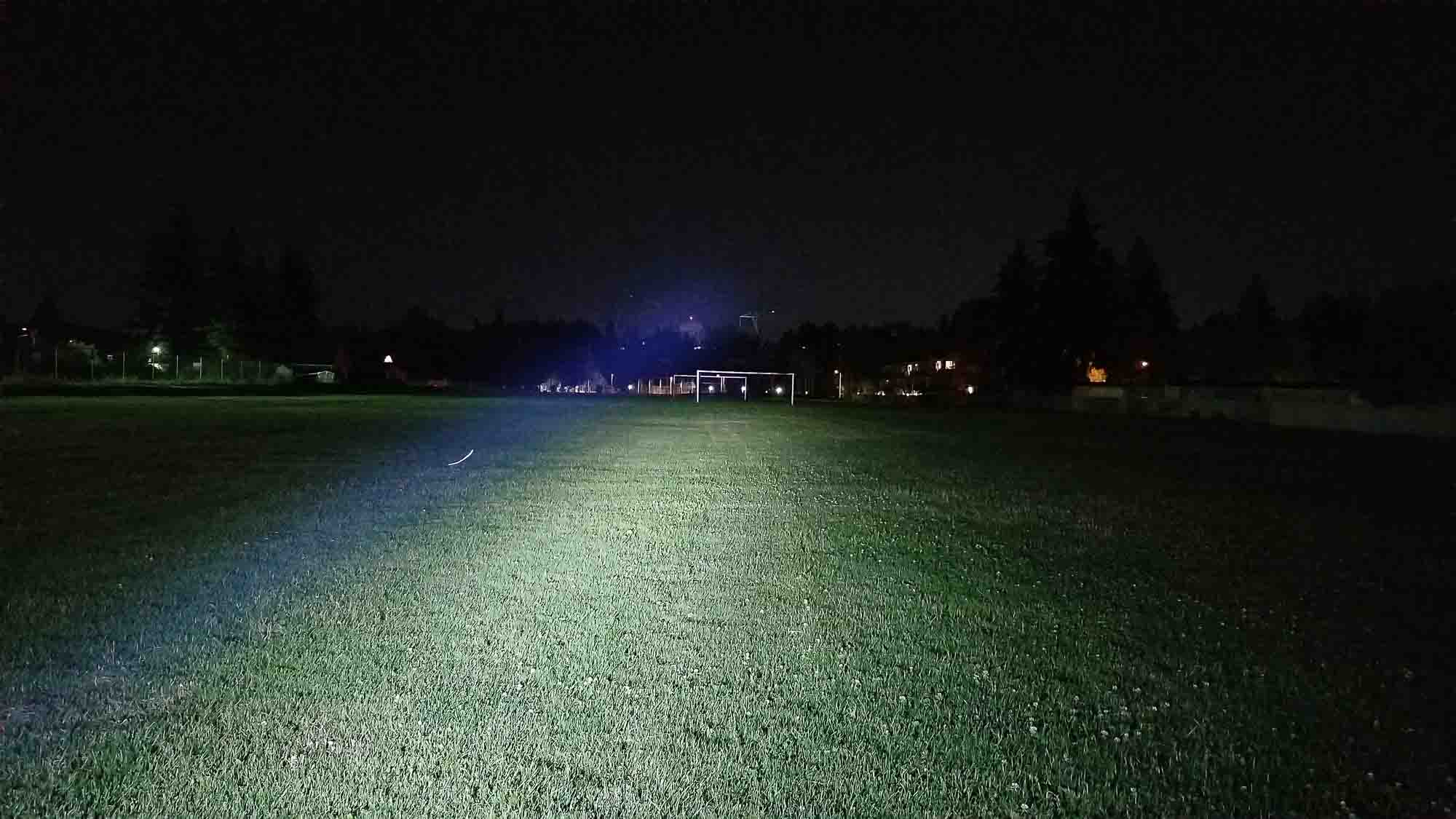
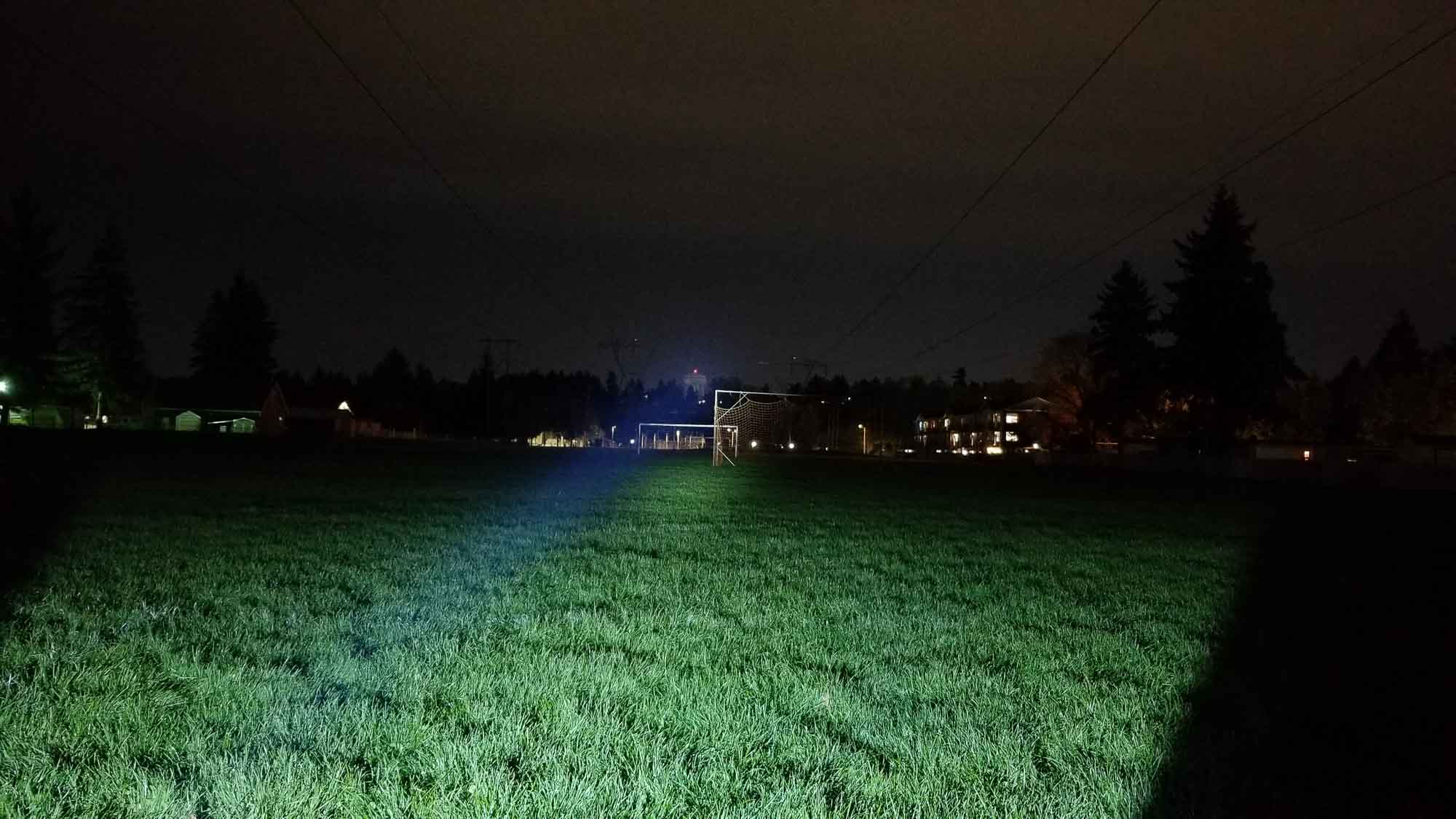
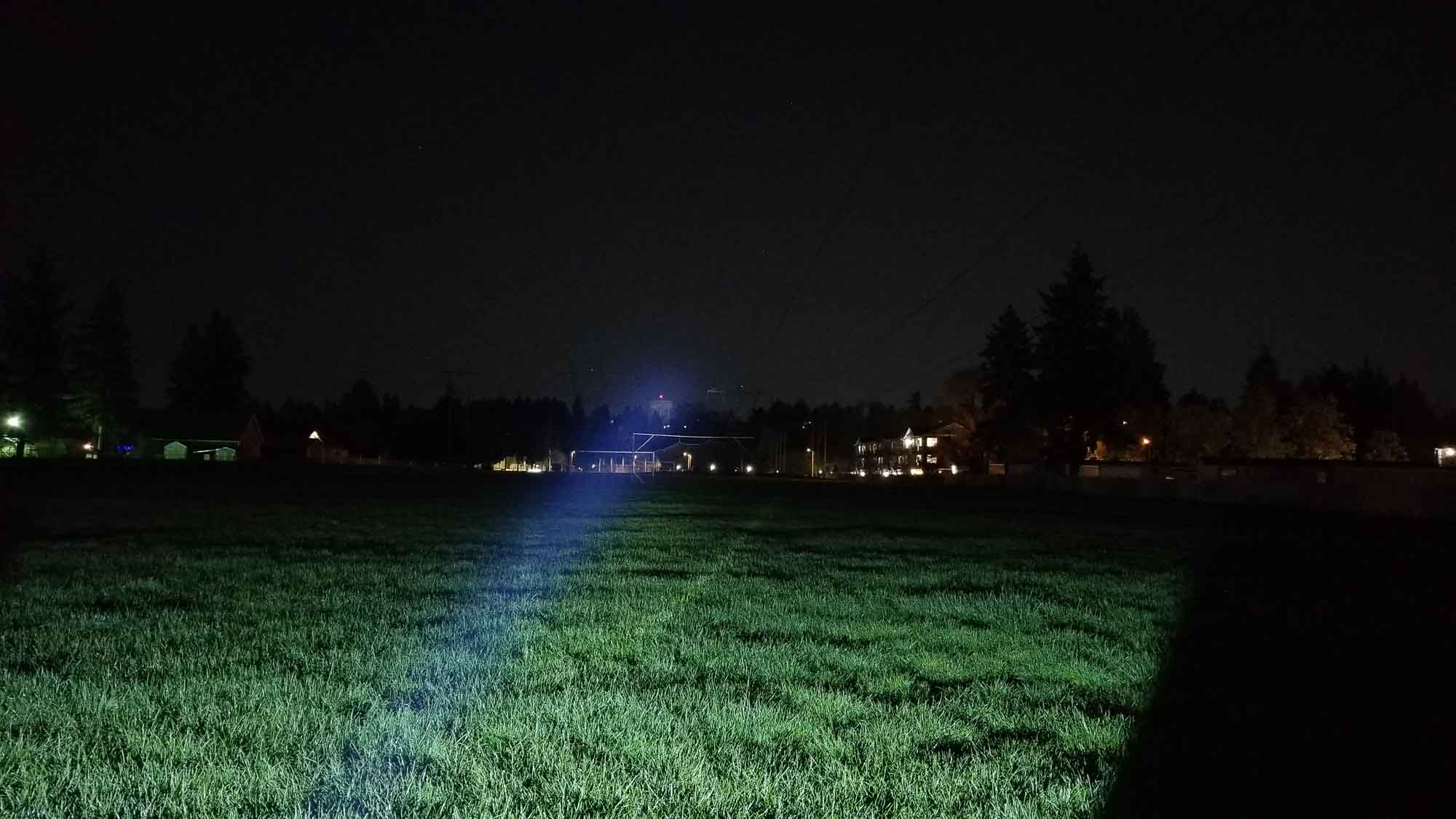


Disclaimer: This flashlight was sent to me for review at no cost by ThruNite. I have not been paid to review, nor have I been holding back on problems or defects.
Final Verdict
Pros
- Great throw and high output
- Nearly perfect thrower beam
- Great multipurpose light
- Nicely regulated boost driver
- Solid build quality
- Full ready to run accessories
Cons
- Abrupt LVP shutdown
- Still using a 26650 in 2022
- Smooth ramping is just okay
Explanation on star ratings:
1: Avoid: a match would be a better choice – 2: Poor: significant defect or issues; almost unusable – 3: Average: some defects or issues; but still usable 4: Good: recommended (minor issues) – 5: Great: highly recommended

4.5 stars: ★★★★⋆
Once again, Thrunite has listened to their consumers and addressed those complaints and suggestions in the only way they know how: With a redesigned flashlight. The Catapult series have fit a special niche in the flashlight hierarchy as compact, high output, long-throw pocket lights. The original Catapult was a great performer and loved by regular consumers and enthusiasts. The updated SST70 Catapult offered quite a bit more output, but much to the chagrin of Catapult faithfuls, deviated from the one metric that the Catapult was praised for; throw. Enter the Catapult Pro. Thrunite not only kept the high output of the SST70, but bumped the candela…a lot. Has this tweaking restored the Catapult to its former glory? Definitely!
The addition of the SFT70 gives a lot more throw, but also maintains high output. Moreover, it has one of the nicest thrower beams I’ve seen in a while, so nice it can be used for general purpose tasks. The UI, while I applaud Thrunite for being adventurous with the addition of smooth ramping, is just adequate and not a standout against Anduril. I’d have preferred the standard stepped modes here. I’d also like to see Thrunite ditch the 26650 and take the 21700 plunge to bring the Catapult platform up to date, but it’s fine as-is. So, should you buy a Catapult Pro if you have an original Catapult? I think so. You’ll get the throw of the XHP35 HI and output of the SST70. Overall, a great light for everyone looking for a pocketable high output, long-throw light. 4.5 stars for the Catapult Pro.
Buy your ThruNite Catapult Pro here:
1lumen selects and reviews products personally. We may earn affiliate commissions through our links, which help support our testing.